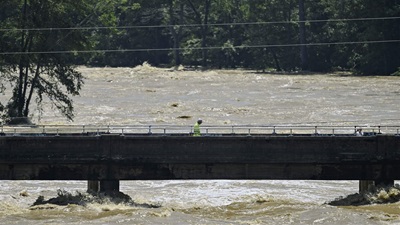5 Reasons Policymakers Should Prioritize Disaster Resilience
Proactive planning can prepare communities for growing risks

Throughout the country, extreme weather events such as flooding, wildfires, and heat waves are becoming more frequent and severe. Planning for and investing in disaster resilience helps communities withstand, adapt to, and bounce back from these events.
1. Extreme Weather Events Are Becoming More Frequent—and More Severe
Weather events and disasters causing large-scale damage and loss of life are growing in both number and intensity. The increase in billion-dollar disasters reflects not only stronger storms and other hazards, but also greater exposure that communities may face from insufficient resilience planning and development patterns that lead to growth in high-risk areas.
Why it matters: Without forward-looking investments and planning, this trend is expected to continue, and governments will face rising costs and growing disruptions in the years ahead.
2. Resilience Investment Pays for Itself—Many Times Over
Extreme weather disasters are taking a rising toll on infrastructure, communities, and local economies. Strategic resilience investments—including nature-based approaches such as restoring wetlands and expanding urban tree canopies—can significantly reduce these risks.
Why it matters: According to an analysis conducted jointly by the U.S. Chamber of Commerce and Allstate, every $1 invested in preparedness and resilience can generate an average of $13 in economic benefit through avoided damage, reduced disruptions, and faster recovery.
3. Local Governments Are on the Front Lines—but Need State and Federal Support
Local emergency management agencies lead disaster response and recovery, but many lack the resources, staffing, and long-term planning capacity to get ahead of increasingly complex and costly events. The ability of local officials to effectively address a wide array of extreme weather depends on reliable support from higher levels of government.
Why it matters: Most states lack formal resilience strategies, clear leadership and coordination, and dedicated funding for new projects. Strengthening local capacity for long-term planning requires action at the state and federal levels—through targeted funding, technical assistance, and disaster recovery and resilience policies that align across jurisdictions.
4. Resilient Infrastructure Protects Communities—and the Economies That Depend on Them
Public infrastructure systems such as transportation networks and water utilities are critical to daily life and local economies. But many are outdated and underfunded, making them highly vulnerable to extreme weather disasters. When these systems fail, the costs to communities and businesses are severe.
Why it matters: Investing in resilient infrastructure—through modernization and nature-based strategies—helps to reduce disruptions, safeguard public health, and protect economic stability. Federal initiatives such as the PROTECT program are helping states and localities strengthen transportation systems against these risks, but states and localities still need broader investment and planning.
5. The Public Supports Resilience—Across the Political Spectrum
Three-fourths of Americans report experiencing extreme weather in the past year. While they may differ on the causes of extreme weather, Americans largely agree on the need to prepare for it. A broad majority—across party lines— supports measures to protect infrastructure and improve disaster preparedness, according to Pew Research Center.
Why it matters: Resilience planning and implementation is a critical and politically viable investment. State and federal leaders who prioritize disaster preparedness can align with public expectations, deliver visible community benefits, and build trust across constituencies.
The Time to Act Is Now
Policymakers and planners can work together to address these threats to cities and states throughout the country, helping to minimize recovery costs and create safer communities.
Mathew Sanders and Forbes Tompkins are senior officers and Kristiane Huber is an officer on the U.S. conservation team working on disaster resilience.










